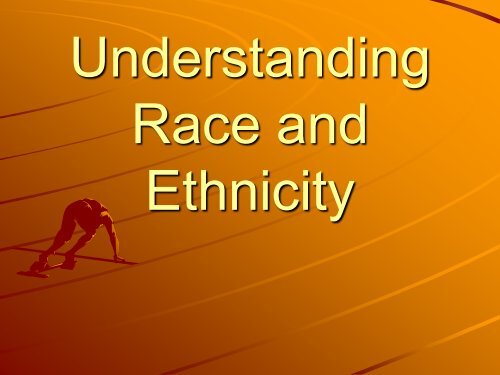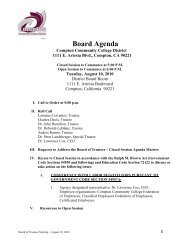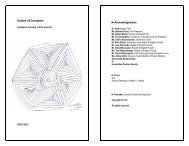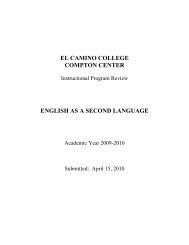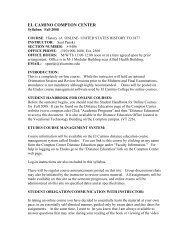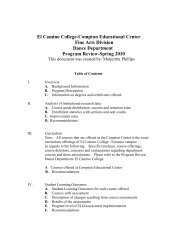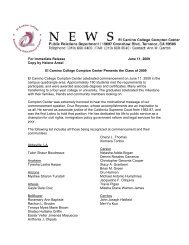What is a Subordinate group?
What is a Subordinate group?
What is a Subordinate group?
Create successful ePaper yourself
Turn your PDF publications into a flip-book with our unique Google optimized e-Paper software.
Understanding<br />
Race and<br />
Ethnicity
Population of the United States by Race<br />
and Ethnicity, 2006 and 2100 (projected)<br />
Population of the U.S. by Race and Ethnicity, 2006 and 2100 (Projected)<br />
According to projections by the census bureau, the proportion of residents of the U.S. who<br />
are White and non-H<strong>is</strong>panic will decrease significantly by the year 2100. By contrast, there<br />
will be a striking r<strong>is</strong>e in the proportion of both H<strong>is</strong>panic Americans and Asian Americans.
Minority Population by State<br />
By the year 2004, non-Whites and Latinos represented a majority of 4 states. Several<br />
more states are close to reaching a “minority majority.”
<strong>What</strong> <strong>is</strong> a <strong>Subordinate</strong> <strong>group</strong>?<br />
<strong>What</strong> does and does not determine minority <strong>group</strong> status<br />
1. Minority status <strong>is</strong> not based on the size of a <strong>group</strong><br />
2. Minority/Majority <strong>group</strong> membership <strong>is</strong> not necessarily<br />
mutually exclusive<br />
3. Minority status may vary according to geopolitical<br />
boundaries<br />
4. Minority/Majority <strong>is</strong> related to the d<strong>is</strong>tribution of power<br />
Five dimensions to a subordinate <strong>group</strong><br />
1. Unequal treatment and less power over one’s life<br />
2. D<strong>is</strong>tingu<strong>is</strong>hing physical or cultural traits that the dominant<br />
<strong>group</strong> holds in low regard<br />
3. Involuntary membership or ascribed status<br />
4. Group solidarity awareness of subordinate status and<br />
oppression<br />
5. Marital endogamy - patterns of in-<strong>group</strong> marriage
Types of <strong>Subordinate</strong> Groups<br />
Racial <strong>group</strong>s - are <strong>group</strong>s that are set apart on the<br />
bas<strong>is</strong> of obvious physical differences within a society<br />
– <strong>What</strong> <strong>is</strong> obvious <strong>is</strong> relative to the <strong>group</strong> or society<br />
Ethnic <strong>group</strong>s - are <strong>group</strong>s that are set apart on the<br />
bas<strong>is</strong> of cultural traits and nationality<br />
Religious <strong>group</strong>s - cons<strong>is</strong>ts of religious associations<br />
that are set apart from the dominant religion<br />
Gender <strong>group</strong>s - such as women who are set apart on<br />
the bas<strong>is</strong> of sex<br />
Other subordinate <strong>group</strong>s - are those that are set apart<br />
on the bas<strong>is</strong> of age, d<strong>is</strong>ability or sexual orientation
Does Race Matter?<br />
Biological school of thought and<br />
meaning of race<br />
Racial <strong>group</strong>s as genetically d<strong>is</strong>crete<br />
population <strong>group</strong>s<br />
– There are subpopulations within the<br />
human race<br />
– That one sub-<strong>group</strong> may be<br />
d<strong>is</strong>tingu<strong>is</strong>hed biologically from another<br />
on the bas<strong>is</strong> of genetic traits
Critic<strong>is</strong>ms of the Biological<br />
View<br />
Genetic traits are continuous so it <strong>is</strong><br />
impossible to state where one <strong>group</strong><br />
begins and ends and another starts<br />
Within <strong>group</strong>, variations are greater<br />
than differences between <strong>group</strong>s<br />
Each trait <strong>is</strong> independent from the<br />
other<br />
Human species contain no sub<strong>group</strong>s
Racial Formation<br />
view of racial formation as the<br />
political and socioh<strong>is</strong>torical process<br />
by which racial categories are<br />
created and change<br />
Dominant <strong>group</strong> has the power to<br />
impose its racial definitions onto<br />
others
The Creation of<br />
<strong>Subordinate</strong>-Group Status<br />
One way <strong>is</strong> through population migration<br />
– Emigration or leaving an area to move<br />
elsewhere such as the Ir<strong>is</strong>h leaving Ireland<br />
– Immigration or coming into an area such as<br />
the Ir<strong>is</strong>h coming to the United States.<br />
– Immigration may be voluntary or it may be<br />
involuntary<br />
Populations usually migrate because of a<br />
combination of push and pull factors
The Creation of<br />
<strong>Subordinate</strong>-Group Status<br />
One way <strong>is</strong> through population<br />
migration<br />
– Push factors - compel people to leave<br />
because of such conditions as war,<br />
famine, overpopulation etc.<br />
– Pull factors - are sources of attraction<br />
such as freedom, occupational<br />
opportunities etc.
The Creation of<br />
<strong>Subordinate</strong>-Group Status<br />
Second pattern by which subordinate<br />
status <strong>is</strong> formed <strong>is</strong> through the<br />
annexation of territory in which an<br />
indigenous <strong>group</strong> <strong>is</strong> incorporated into<br />
another society<br />
Third pattern <strong>is</strong> through colonial<strong>is</strong>m -<br />
which <strong>is</strong> the political, socio-cultural and<br />
economic domination of an indigenous<br />
population by a foreign power
Spectrum of Inter<strong>group</strong><br />
Relations
Seven Consequences of<br />
<strong>Subordinate</strong>-Group Status<br />
Genocide - systematic extermination of<br />
subordinate <strong>group</strong> at the hands of the<br />
dominant <strong>group</strong> (Example, Germany and<br />
Jews, Rwanda and the war between the Hutu<br />
and Tutsi and Muslims from Bosnia.)<br />
Expulsion - dominant <strong>group</strong> expels a<br />
subordinate <strong>group</strong> (Example, Native<br />
Americans, Indians in Uganda)<br />
Secession - A subordinate <strong>group</strong> ceases to<br />
be a subordinate <strong>group</strong> when it secedes from<br />
the dominate <strong>group</strong> and forms a new nation<br />
(Example, Baltic States from Russia)
Seven Consequences of<br />
<strong>Subordinate</strong>-Group Status<br />
Segregation - where the dominant <strong>group</strong><br />
structures the social institutions in society to<br />
maintain minimal contact with subordinate<br />
<strong>group</strong>s (Example, the South in the 1950’s)<br />
Fusion - refers to the biological and cultural<br />
amalgamation of ethnic <strong>group</strong>s in society<br />
– Fusion can be expressed as A+B+C=D, in<br />
which A, B ,C are different <strong>group</strong>s and<br />
interaction between the <strong>group</strong>s produce<br />
something new D, the blending of the three<br />
<strong>group</strong>s.
Seven Consequences of<br />
<strong>Subordinate</strong>-Group Status<br />
Assimilation - refers to the absorption of the<br />
subordinate <strong>group</strong> into the dominant <strong>group</strong>’s<br />
culture and society<br />
– Assimilation can be represented by A+B+C=A<br />
in which A <strong>is</strong> the dominant <strong>group</strong> and B and C<br />
are subordinate <strong>group</strong>s.<br />
Plural<strong>is</strong>m - refers to ethnic diversity and the<br />
multiplicity of ethnic cultures in which each <strong>is</strong><br />
respected and accorded equal status<br />
– Plural<strong>is</strong>m can be represented as<br />
A+B+C=A+B+C. In which A, B, C represent<br />
different <strong>group</strong>s and interaction results in<br />
plural cultures coex<strong>is</strong>ting on an equal status.
White-Black<br />
Segregation, 2000<br />
White-Latino<br />
Segregation, 2000
Typical Metropolitan Neighborhoods: Continued<br />
Segregation from Each Other<br />
The basic message <strong>is</strong> that Whites live in neighborhoods with low minority<br />
representation whereas minorities live in neighborhoods with high minority<br />
representation and limited White representation.<br />
Source: Analys<strong>is</strong> of the 2000 census by the Lew<strong>is</strong> Mumford Center (2001,<br />
www.albany.edu/mumford/census).
Race and Ethnicity, 15<br />
Largest Cities, 2005
Multiple Race Choices in<br />
Census 2000<br />
Th<strong>is</strong> figure shows the percentage d<strong>is</strong>tribution of the 6.8 million people who chose two or more races<br />
(out of the total population of 281.4 million).<br />
Source: Grieco and Cassidy 2001.


